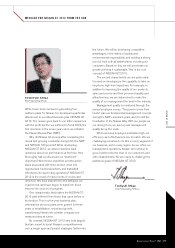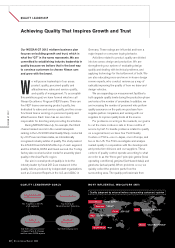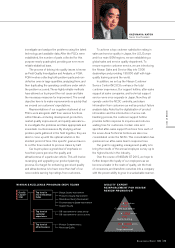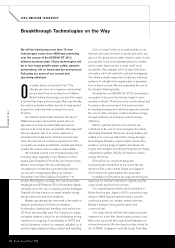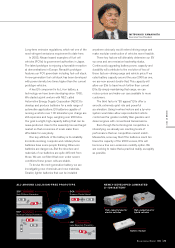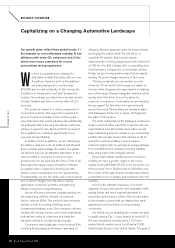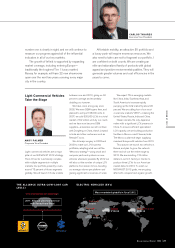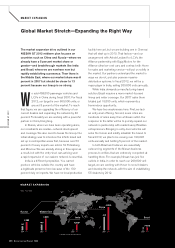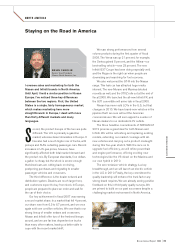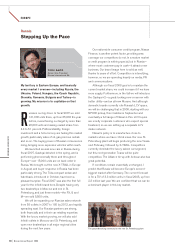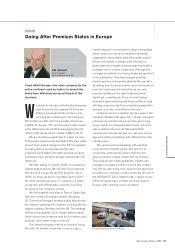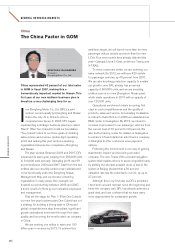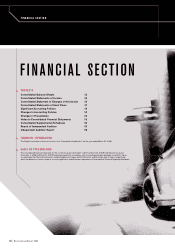Nissan 2008 Annual Report Download - page 32
Download and view the complete annual report
Please find page 32 of the 2008 Nissan annual report below. You can navigate through the pages in the report by either clicking on the pages listed below, or by using the keyword search tool below to find specific information within the annual report.
30 Nissan Annual Report 2008
NISSAN GT 2012
COST LEADERSHIP
Cost Leadership at Nissan
We made a significant improvement in our
purchase cost competitiveness during the
Nissan Revival Plan (NRP), NISSAN 180 and
NISSAN Value-Up years. Strong value-added
activities with our suppliers—known as 3-3-3
activity—have supported all three plans.
Approximately half of the cost reductions made
were the result of this type of activity.
Our Alliance with Renault has been another
major driver through our common purchase
organization, the Renault Nissan Purchasing
Organization (RNPO). The RNPO has
increased its coverage from 30 percent of the total
purchase amount 2001 to 70 percent in 2004. That
rose to 90 percent in April 2008, and this
organization now covers all parts and materials. We
can now enjoy the huge economies of scale that
come from the Alliance’s combined production of
over six million vehicles throughout most of our
scope of purchase activity.
During the NISSAN Value-Up period, we made
strong efforts to develop sourcing from leading
competitive countries (LCCs). We have also
increased competitive localization to more than 60
percent in our major LCC manufacturing operations,
and we expanded purchases from LCCs for our
manufacturing operations in high-cost countries from
12 to 24 percent during that three-year period.
Economic environment and outlook
LCC sourcing development has been closely
associated with the rapid growth and evolution of the
automotive industry in those emerging countries in
recent years. We see this evolution itself as a huge
business opportunity in terms of both market
expansion and also competitive industrial base
development. At the same time, however, we have
been hit by sizable increases in raw material and
energy costs over the last three years—as much as
300 billion yen on a global basis.
Those two clear and correlating trends—
combined with the continuous economic growth of
emerging countries, natural resource-oriented
inflationary pressures on material costs, and the
sluggishness of mature markets such as the U.S.,
Western Europe and Japan—will be factors for at
least the first several years of NISSAN GT 2012.
Under these circumstances, it is obvious that
optimizing cost reductions will be a crucial element
to protect our healthy business growth in coming
years. We are devising a plan to boost our cost
reduction pace to 5 percent per annum. I believe this
is the minimum level of performance needed in the
present business environment.
NISSAN GT 2012’s five challenges
To achieve the reductions mentioned, we need to
boost productivity and 3-3-3 activity to the maximum
level, which will require strong support from our
suppliers. Observing the magnitude of the task at
hand, I am convinced that we must radically improve
the efficiency of our whole manufacturing and supply
chain system. I would like to share with you our main
challenges in this regard.
The first is to radically increase our production
volume per part or part number, which will provide
significant cost efficiency to supplier operations. This
volume increase will have two sources. One is our
planned business growth in Russia and GOM. The
second will be a reduction in part complexity and
product diversity. We are aiming to double our
production volume per part, which will place us at the
industry’s top level of efficiency. The Alliance figures
into this prominently, and we are already working
with Renault teams on related aspects.
The next challenge is deeper localization with
suppliers in the LCCs—the second step in our LCC
sourcing challenge. We are aiming for 90 percent
localization, and the same level for tier 2 and tier 3
components and materials. We will achieve this by
generating design specifications that can be easily
met in local markets. This activity will cover raw
material specifications as well.
An important milestone related to this activity
occurs in 2010, when we launch our newly
developed small-platform vehicles. Our current plan
is to have five LCC manufacturing sites covering
worldwide markets, including mature markets. In that
regard, superior quality is a mandatory condition for
success on top of cost competitiveness.



